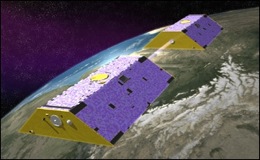Rachel Cohen is a Bay Area freelance writer, presently serving an internship with Climate Watch.

To boldly go–where we already live
By Rachel Cohen
NASA will likely be focusing more attention on the “pale blue dot” in coming years, with a reinvigorated Earth Science Program. California’s freshwater supply and sea level change are among the features that will be studied by replacing an aging satellite.
The proposed White House budget for the National Aeronautics and Space Administration includes billions of dollars for satellites and other tech tools to help scientists investigate Earth-bound problems, especially climate change. Part of the program will be steered from Pasadena’s Jet Propulsion Laboratory, which will manage two key missions connected with the program. JPL spokesman Alan Buis says the White House support may provide stability for gathering the kind of long-term data sets needed to study gradual changes in earth systems.
As Jon Hamilton reports in his story for NPR’s Morning Edition, the centerpiece of the program will be the GRACE satellite which will collect data critical for a variety of models and applications, including:
· The changing mass of polar ice caps
· Changes in water resources on land
· Shallow and deep ocean current transport mechanisms
· Sea level change resulting from ocean temperature and water mass changes
· Exchanges between the oceans and atmosphere
· Forces that generate Earth’s geomagnetic field, and
· Internal Earth forces that move tectonic plates and result in earthquakes and volcanic eruptions
GRACE has been in orbit since 2002 and is due to be replaced. NASA suffered a severe setback when its Orbiting Carbon Observatory (OCO) satellite crashed after its launch early last year. The White House budget includes funding to rebuild the vehicle and relaunch in February of 2013. The OCO2 satellite is designed to measure carbon dioxide in the atmosphere, specifically comparing sources of CO2 to “sinks,” where it is stored.
One thought on “NASA Looking More Earthward”
Comments are closed.

http://www.americanthinker.com/blog/2010/03/what_could_be_more_wrong_than.html
——————
E-mail messages obtained by a Freedom of Information Act request reveal that NASA concluded that its own climate findings were inferior to those maintained by both the University of East Anglia’s Climatic Research Unit (CRU) — the scandalized source of the leaked Climate-gate e-mails — and the National Oceanic and Atmospheric Administration’s National Climatic Data Center.
———–
More inconvenient truth I guess.